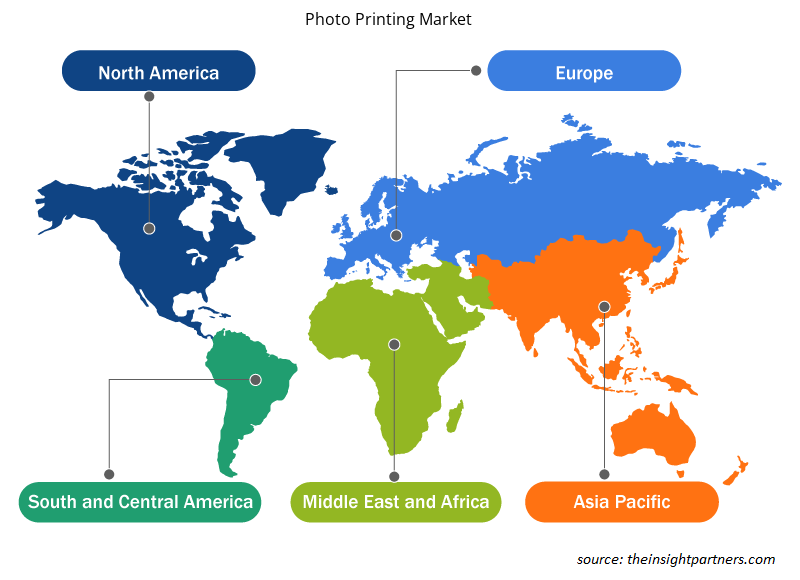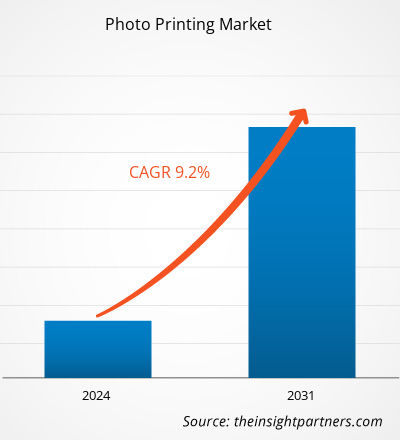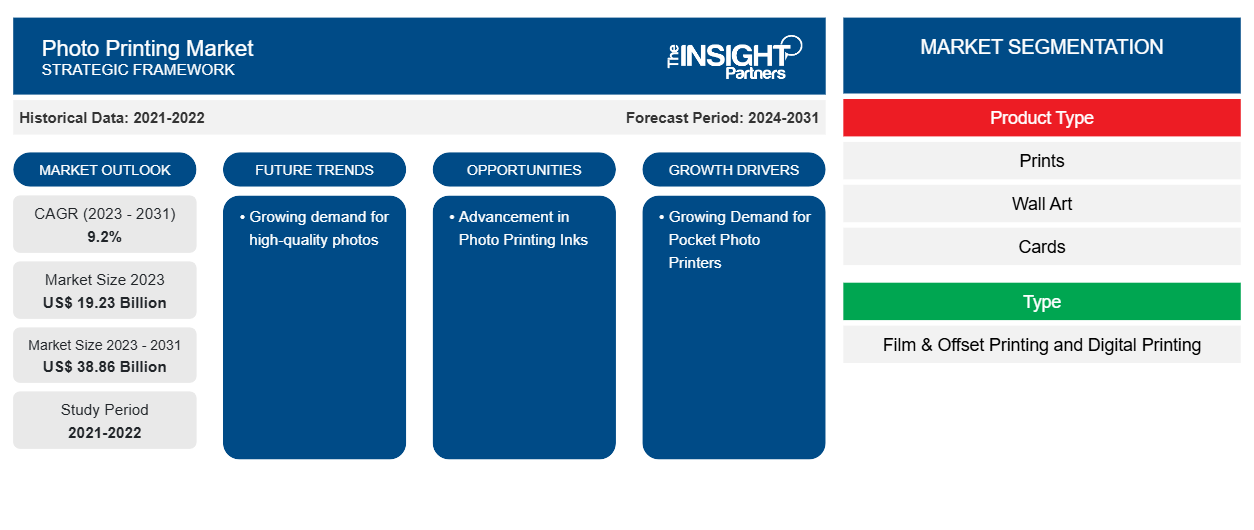Si prevede che la dimensione del mercato della stampa fotografica raggiungerà i 19,23 miliardi di dollari entro il 2031, rispetto ai 38,86 miliardi di dollari del 2023. Si prevede che il mercato registrerà un CAGR del 9,2% nel 2023-2031. È probabile che la crescente domanda di foto di alta qualità rimanga una tendenza chiave del mercato della stampa fotografica.CAGR of 9.2% in 2023–2031. Growing demand for high-quality photos is likely to remain a key photo printing market trend.
Analisi della stampa fotografica
Il mercato della stampa fotografica sta crescendo a un ritmo rapido a causa della crescente domanda di stampanti fotografiche tascabili e della crescente richiesta da parte dei consumatori di stampe fotografiche uniche e personalizzate. Il mercato si sta espandendo costantemente, spinto dalla crescente domanda di tecnologie di stampa eco-compatibili. Inoltre, i progressi negli inchiostri per la stampa fotografica e la crescente domanda di stampa senza inchiostro stanno offrendo opportunità redditizie per la crescita del mercato. eco-friendly printing technologies. Moreover, advancements in photo printing inks and the increasing demand for inkless printing is providing lucrative opportunities for market growth.
Panoramica del mercato della stampa fotografica
La stampa fotografica si riferisce a un processo che converte le informazioni digitali, come immagini o video, in stampe tangibili che vengono esposte in vetrine, mostre e display. Questo processo prevede l'uso di una stampante fotografica per trasferire immagini digitali o stampe scansionate su carta o altri materiali. Le stampanti fotografiche sono principalmente progettate e utilizzate per generare stampe di alta qualità con colori accurati e dettagli precisi. Esistono numerose tecniche di stampa, come carta , metallo e tela, utilizzate per la stampa fotografica.
Personalizza questo report in base alle tue esigenze
Riceverai la personalizzazione gratuita di qualsiasi report, comprese parti di questo report, o analisi a livello nazionale, pacchetto dati Excel, oltre a usufruire di grandi offerte e sconti per start-up e università
-
Scopri le principali tendenze di mercato in questo rapporto.Questo campione GRATUITO includerà analisi di dati che spaziano dalle tendenze di mercato alle stime e alle previsioni.
Driver e opportunità del mercato della stampa fotografica
La crescente domanda di stampanti fotografiche tascabili sta guidando il mercato
Le stampanti fotografiche tascabili hanno guadagnato popolarità negli ultimi anni. Queste stampanti sono portatili e solitamente si collegano a telefoni o altri dispositivi tramite Bluetooth, consentendo agli utenti di stampare da qualsiasi luogo. Le stampanti fotografiche tascabili sono incredibilmente utili nella vita di tutti i giorni, specialmente per i professionisti creativi. Inoltre, la crescente industria dei viaggi e del turismo aumenta l'adozione di stampanti fotografiche tascabili tra i viaggiatori, dando una spinta al mercato.
Progressi negli inchiostri per la stampa fotografica
La tecnologia di stampa ha fatto notevoli progressi nello sviluppo di inchiostri specificamente progettati per la fotografia paesaggistica (o qualsiasi immagine). Produttori come Epson, Canon e HP hanno aperto la strada alla creazione di inchiostri a base di pigmenti che producono stampe incredibilmente brillanti e durature. Questi inchiostri sono composti da particelle microscopiche che galleggiano in una base liquida, offrendo una gamma di colori più ampia e una migliore resistenza allo sbiadimento rispetto agli inchiostri a base di coloranti. Ad esempio, Epson, nota per la sua tecnologia PrecisionCore, potrebbe aver stabilito uno standard di settore con i suoi inchiostri UltraChrome Pro. Gli inchiostri a base di pigmenti migliorano la consistenza della lucentezza e riducono l'effetto bronzato, conferendo un aspetto ancora più liscio e raffinato.PrecisionCore technology, may have set an industry standard with its UltraChrome Pro inks. Pigment-based inks improve gloss consistency and decrease bronzing, giving an even smoother and more refined appearance.
Analisi della segmentazione del rapporto sul mercato della stampa fotografica
I segmenti chiave che hanno contribuito alla derivazione dell'analisi del mercato della stampa fotografica sono il tipo di prodotto, la tipologia e il canale di distribuzione.
- In base al tipo di prodotto, il mercato della stampa fotografica è suddiviso in stampe, arte murale, biglietti, regali fotografici, libri fotografici, calendari e altri. Il segmento delle stampe ha detenuto una quota di mercato maggiore nel 2023.
- In base al tipo, il mercato della stampa fotografica è suddiviso in stampa offset e su pellicola e stampa digitale. Il segmento della stampa digitale ha detenuto una quota di mercato maggiore nel 2023.
- In termini di canale di distribuzione, il mercato è segmentato in vendita al dettaglio, online e chiosco istantaneo. Il segmento online ha detenuto la quota maggiore del mercato nel 2023.
Analisi della quota di mercato della stampa fotografica per area geografica
L'ambito geografico del rapporto sul mercato della stampa fotografica è suddiviso principalmente in cinque regioni: Nord America, Asia Pacifico, Europa, Medio Oriente e Africa e Sud America/Sud e Centro America.
In termini di fatturato, il Nord America ha rappresentato la quota di mercato più grande per la stampa fotografica. Il mercato in questa regione è segmentato in Stati Uniti, Canada e Messico. Il crescente utilizzo della fotografia digitale per scopi personali sta guidando il mercato. La crescente digitalizzazione e il crescente utilizzo di smartphone tra i consumatori per catturare e condividere foto stanno guidando il mercato durante il periodo di previsione.
Approfondimenti regionali sul mercato della stampa fotografica
Le tendenze regionali e i fattori che influenzano il mercato della stampa fotografica durante il periodo di previsione sono stati ampiamente spiegati dagli analisti di Insight Partners. Questa sezione discute anche i segmenti e la geografia del mercato della stampa fotografica in Nord America, Europa, Asia Pacifico, Medio Oriente e Africa e America meridionale e centrale.

- Ottieni i dati specifici regionali per il mercato della stampa fotografica
Ambito del rapporto sul mercato della stampa fotografica
| Attributo del report | Dettagli |
|---|---|
| Dimensioni del mercato nel 2023 | 19,23 miliardi di dollari USA |
| Dimensioni del mercato entro il 2031 | 38,86 miliardi di dollari USA |
| CAGR globale (2023-2031) | 9,2% |
| Dati storici | 2021-2022 |
| Periodo di previsione | 2024-2031 |
| Segmenti coperti |
Per tipo di prodotto
|
| Regioni e Paesi coperti |
America del Nord
|
| Leader di mercato e profili aziendali chiave |
|
Densità degli attori del mercato: comprendere il suo impatto sulle dinamiche aziendali
Il mercato della stampa fotografica sta crescendo rapidamente, spinto dalla crescente domanda degli utenti finali dovuta a fattori quali l'evoluzione delle preferenze dei consumatori, i progressi tecnologici e una maggiore consapevolezza dei vantaggi del prodotto. Con l'aumento della domanda, le aziende stanno ampliando le loro offerte, innovando per soddisfare le esigenze dei consumatori e capitalizzando sulle tendenze emergenti, il che alimenta ulteriormente la crescita del mercato.
La densità degli operatori di mercato si riferisce alla distribuzione di aziende o società che operano in un particolare mercato o settore. Indica quanti concorrenti (operatori di mercato) sono presenti in un dato spazio di mercato in relazione alle sue dimensioni o al valore di mercato totale.
Le principali aziende che operano nel mercato della stampa fotografica sono:
- Società Fujifilm
- Adorama Camera, Inc.
- Laboratorio fotografico della baia
- Società a responsabilità limitata
- Laboratorio fotografico delle Nazioni
- La Walgreens Co.
Disclaimer : le aziende elencate sopra non sono classificate secondo un ordine particolare.

- Ottieni una panoramica dei principali attori del mercato della stampa fotografica
Notizie e sviluppi recenti sul mercato della stampa fotografica
Il mercato della stampa fotografica viene valutato raccogliendo dati qualitativi e quantitativi dopo la ricerca primaria e secondaria, che includono importanti pubblicazioni aziendali, dati associativi e database. Di seguito è riportato un elenco degli sviluppi nel mercato della stampa fotografica e delle strategie:
- A luglio 2022, Canon Inc ha annunciato la SELPHY CP1500, una nuova stampante fotografica compatta wireless facile da usare che promette di deliziare con stampe personalizzate e di alta qualità. La SELPHY CP1500 migliora ulteriormente la vividezza delle stampe di ritratti. Oltre all'uso della tecnologia di sublimazione del colore, che consente toni di colore più uniformi e gradazioni più ricche, la SELPHY PRINTER CP 1500 è dotata di una funzione di correzione automatica che regola luminosità, saturazione, contrasto e toni nelle immagini per una finitura migliore e più chiara. (Fonte: Canon Inc, comunicato stampa, 2022)
Copertura e risultati del rapporto sul mercato della stampa fotografica
Il rapporto "Dimensioni e previsioni del mercato della stampa fotografica (2023-2031)" fornisce un'analisi dettagliata del mercato che copre le seguenti aree:
- Dimensioni e previsioni del mercato a livello globale, regionale e nazionale per tutti i segmenti di mercato chiave coperti dall'ambito
- Dinamiche di mercato come fattori trainanti, vincoli e opportunità chiave
- Principali tendenze future
- Analisi dettagliata delle cinque forze PEST/Porter e SWOT
- Analisi di mercato globale e regionale che copre le principali tendenze di mercato, i principali attori, le normative e gli sviluppi recenti del mercato
- Analisi del panorama industriale e della concorrenza che copre la concentrazione del mercato, l'analisi della mappa di calore, i principali attori e gli sviluppi recenti
- Profili aziendali dettagliati
- Analisi storica (2 anni), anno base, previsione (7 anni) con CAGR
- Analisi PEST e SWOT
- Valore/volume delle dimensioni del mercato - Globale, Regionale, Nazionale
- Industria e panorama competitivo
- Set di dati Excel
Report recenti
Rapporti correlati
Testimonianze
Motivo dell'acquisto
- Processo decisionale informato
- Comprensione delle dinamiche di mercato
- Analisi competitiva
- Analisi dei clienti
- Previsioni di mercato
- Mitigazione del rischio
- Pianificazione strategica
- Giustificazione degli investimenti
- Identificazione dei mercati emergenti
- Miglioramento delle strategie di marketing
- Aumento dell'efficienza operativa
- Allineamento alle tendenze normative























 Ottieni un campione gratuito per - Mercato della stampa fotografica
Ottieni un campione gratuito per - Mercato della stampa fotografica